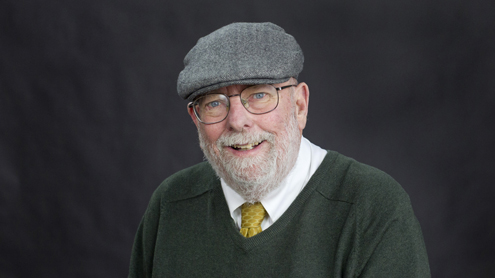
Terry Jones is a professor and chair of the Department of Political Science at UMSL. (Photo by August Jennewein)
With time comes perspective, and the 44 years that Terry Jones has worked for the University of Missouri–St. Louis have provided the political science professor with a view that’s unique and revealing.
Still in his twenties, he joined UMSL in 1969 – six years after it opened. Jones grew up in St. Louis and earned a bachelor’s degree in economics at Saint Louis University. He edited the student newspaper there, worked as a stringer for the St. Louis Globe-Democrat and planned to pursue a career in journalism.
But in the early 1960s, the higher-education community and the federal government recognized that, without action, there wouldn’t be enough university faculty to handle America’s oncoming wave of college students who were baby boomers. Strong undergraduates, like Jones, were recruited into doctoral programs with offers of assistantships and fellowships. He went on to earn a doctoral degree at Georgetown University in Washington.
At UMSL, he’s been the chair of the Department of Political Science twice, including his current stint, which began in 2010. Jones directed the Public Policy Administration Program, and he was the dean of the College of Arts and Sciences from 1983 to 1997.
His research covers public policy, metropolitan governance, public opinion, strategic planning and surveying. He’s written three books, including “The Metropolitan Chase: Politics and Policies in Urban America.”
What drew you to higher education? *
I really loved the autonomy one had as a university professor. You had a lot to say about what you taught. You had a lot to say about what you read and researched. I also became very excited about the ability to have universities serve the public through advancing knowledge and their educational mission.
UMSL was in its infancy when you came here in 1969. What was attractive about joining the university?
It was an emerging metropolitan public university, and that’s the type of university I wanted to be a part of. We were developing a public university in a metropolitan area that serves the area primarily through teaching and research but also by extending that teaching and research into the community. It was exciting. At that point, I was 28 years old. I was very eager to make a difference – not simply as an individual scholar but in shaping an institution. UMSL offered me the opportunity to do that at a young age.
The College of Arts and Sciences evolved quite a bit under your leadership. What was your focus then?
I had a passion about connecting the university to the community. There were 18 departments in the college. I worked with many of them to help them think through what being in a metropolitan area meant, how that was different for them and how they might adjust their programs and approach to take advantage of our location. For example, we really built the criminology and criminal justice department. Safety is an important issue in a metropolitan area and to have a program that researched in that area and delivered advice was critical.
There have always been competing thoughts and ideas about how UMSL should evolve. What good comes from that competition? *
There weren’t many blueprints for young, public, metropolitan universities. We had to find our own way. Even people who are arguing with each other – we all shared a common goal to make this the best possible university we could. We often disagree about whether action A or action B is the best way to make that happen, but that’s healthy tension. For the most part, I think we’ve gotten it right.
There have been many changes to the university since it was established. What’s an important one that comes to mind?
I think one very significant change is that about 15 years ago we very consciously, as an institution, said, “We don’t have enough international students on campus.” For a lot of our students it’s not feasible to study abroad, so if you can’t send students overseas, then you bring overseas to the students. Now we’re up to around 1,000 international students, so if you’re teaching a class, there are two to five international students in the classroom. The face of the campus is different and better.
What about students overall? Have they changed much in 44 years?
This is not every UMSL student, but the prototypical UMSL student remains the same. They are between 25 and 35. For one or another reason, they didn’t go to college right away or more frequently went a bit and got distracted. But then they come here, and they’re very serious about education and somewhat concerned about their ability to succeed. We are a bootstrap for them, and they are a joy to not only teach but to watch develop in the community. It’s very satisfying to see our alumni in those pictures of St. Louis leaders in a publication like the St. Louis Business Journal and say, “That’s what we were thinking of in the 1970s and 1980s.”
UMSL is older than an infant or a toddler, but what are we now? *
We’re in our 30s. There are some accomplishments we can look back on with satisfaction and encouragement. Yes, we’re worthwhile. Yes, we made a difference. But we can do more, because we’re not in our 70s or 80s – even though some of us actually are in our 70s.
This story was originally published in the spring 2013 issue of UMSL Magazine. (* Did not appear in original version.)














